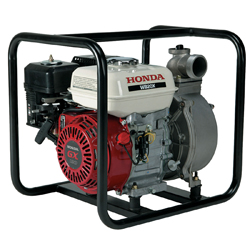 Honda water pumps are excellent, durable water pumps, with a great reputation of reliability. Despite this reputation, once in a while, something goes awry. Whether it’s a faulty part, operator error or a more complex problem, we’ve got you covered. Use the following troubleshooting guide to ascertain if you can fix the problem yourself or if you need a repairman. Use the manufacturer’s operations manual as a guide when embarking on a troubleshooting mission. As always, if you need Honda water pump parts contact www.hondalawnparts.com.
Honda water pumps are excellent, durable water pumps, with a great reputation of reliability. Despite this reputation, once in a while, something goes awry. Whether it’s a faulty part, operator error or a more complex problem, we’ve got you covered. Use the following troubleshooting guide to ascertain if you can fix the problem yourself or if you need a repairman. Use the manufacturer’s operations manual as a guide when embarking on a troubleshooting mission. As always, if you need Honda water pump parts contact www.hondalawnparts.com.
The following is a troubleshooting guide that addresses some of the more common problems found with water pumps:
Issue: After three minutes, pump won’t prime.
The first step is to check whether or not the pump housing is filled with water. If not, fill it, and see if that solves the problem. If that doesn’t work, check if the static suction head is too high. Lower it closer to the water and try again. If it still doesn’t prime, the suction hose may be too long. Replace it with a shorter hose.
If your suction hose is leaking, it can also prevent the pump from priming. Repair or replace the hose or the coupler, whichever is leaking. If the pump still won’t prime, check if the strainer head is clogged. If it is, simply clean it and try again.
If none of the above work, perform a vacuum test to see if the internal mechanism is functioning properly. Fill the pump with water. Attach a vacuum gauge to the suction port. With the discharge hose removed, start the pump. Set the throttle to fast. If the pump is working properly, the gauge should read at least 20 inch Hg. If it’s lower, the internal components of the pump may be worn. If the engine is too slow, the engine could be the problem. For replacement parts, visit www.hondalawnparts.com.
Issue: Low discharge pressure or capacity.
Check if the engine speed is correct. If it is correct, the problem may be that the discharge hose is too long or too narrow. Replace the hose with a hose of a more suitable size. It’s also possible that the volute and impeller are worn. Water can contain abrasive materials that wear down a pump. If the water you’re pumping is clean, this will not be an issue. If it’s not, use a Honda Trash Pump instead. It’s also possible that the pump is damaged by cavitation — if so, refer to the appropriate section.
If the speed of the engine is too slow, you may have a different issue. Check to make sure the engine throttle is set to fast. If it is, and the engine speed is still too low, the engine may be worn or you may have a governor problem.
Issue: Pump cavitates, causing a grinding noise and a worn impeller.
Check to see if the strainer is clogged. If it is, clean it. If debris is collecting in the strainer, submerge a bucket and keep the strainer in it for as long as possible while pumping.
It’s also possible that the suction hose is improperly sized. Always try to use the shortest suction hose, because extra length reduces the efficiency of the pump. The pump hose should also be at least as large in diameter as the suction port.
Issue: The pump’s housing is cracked or broken.
It’s possible that damage to the pump housing was caused by a vehicle running over the discharge hose, causing water hammer. To avoid this, make sure the hose is not stretched where a vehicle would drive. If this didn’t happen, it’s also possible that there was excess water in the housing which was allowed to freeze. Make sure you always drain water from the pump housing after use.
Water hammer can also be caused by shutting off the water flow too quickly with a very long discharge hose. If this is the case, either use a shorter discharge hose or shut off the water flow more gradually.
Issue: Water is leaking between the engine and the pump case.
This issue is caused by a worn mechanical seal. The most common causes are: pumping water that contains abrasives, running the pump dry, or shutting off the flow of water for an extended period of time.
Issue: Engine will not turn over.
If the engine does not turn over, there could be something lodged in the impeller or the volute. To avoid this problem in the future, always use the appropriate Honda strainer with the pump suction hose, and avoid pumping water filled with abrasives. To fix the problem, carefully remove any debris while the engine is off, or take it to a certified repair location.
Remember to avoid problems in the future, always use a suction and discharge hose of the appropriate diameter and as short as possible. Always avoid pumping water that contains abrasives without a pump designed to handle them.
If you need repair parts for your Honda water pump, you can find them at www.hondalawnparts.com.
